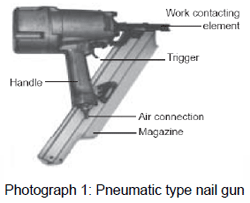Nail guns, like all power tools, pose inherent dangers, as their force can propel a nail through human bone. WorkCover Queensland emphasizes the importance of training for all workers utilizing nail guns to ensure safe usage.
Training covers essential aspects such as proper operation of the nail gun, requirements for personal protective equipment (PPE), and adherence to manufacturer's manual instructions. Additional information on safe usage may be sought from training organizations, industry associations, or manufacturers.
To mitigate risks, workers must maintain their nail guns, ensuring the actuation mechanism functions correctly. Any issues should be addressed promptly by a competent person, authorized agent, or by replacing the malfunctioning nail gun. The use of a faulty nail gun is strongly discouraged.
Various portable, hand-held nail guns are powered by electromagnetism, compressed air (pneumatic), highly flammable gases (butane or propane), or powder actuated with an explosive charge.
In terms of risks, most injuries result from accidental contact of the gun's muzzle with the body while the trigger switch is engaged. This typically occurs with 'contact trip actuation' guns, prone to accidental firing due to sensitive spring compression units within the muzzle.

Injuries may include nails penetrating the body through direct contact, deflection off hard surfaces, or penetration through soft or thin materials. Others nearby can inadvertently position themselves in the projectile path, leading to severe consequences, including disability or fatality.
To ensure safety, all workers using any type of nail gun must undergo comprehensive training covering safe operation, PPE requirements, and manufacturer's manual directions.
For jobs involving high volume production and repetitive tasks, bump-fire nail guns may be used, provided strict safety measures are in place:
- Establishing an appropriate exclusion zone around the nailing operation.
- Using signage to alert people to the nailing tool in use.
- Reassigning non-involved workers away from the nailing area.
- Ensuring users and at-risk workers wear appropriate eye and hearing protection and additional PPE as specified in the user's manual and comply with all worksite rules.
However, there are circumstances where bump-fire guns must not be used:
- Climbing ladders or elevated areas with a loaded gun.
- In restricted or tight spaces where the gun's muzzle may be bumped.
- Where others could enter the firing path, risking being struck by a flying nail (e.g., ricochet or deflection).
WorkCover Queensland advocates for the use of sequential firing mechanisms as a safer option, promoting nail guns with this feature over bump-fire types.
